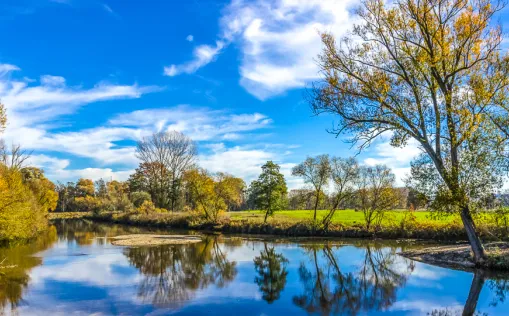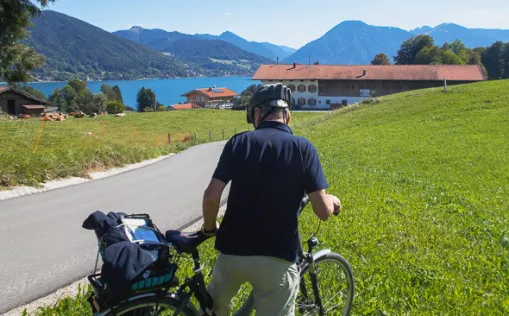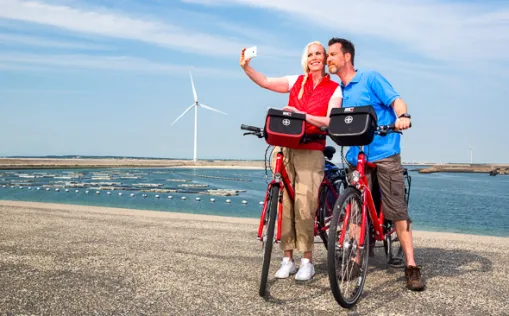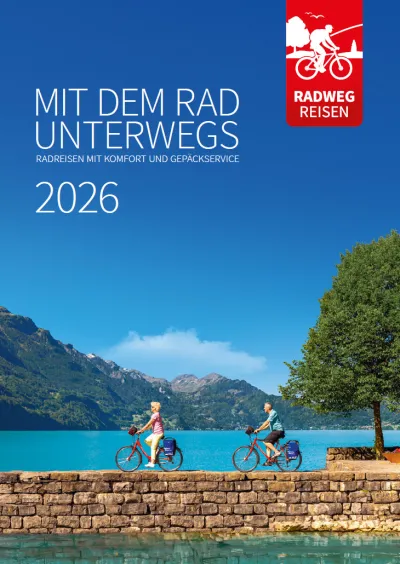

Travel report: The Five Rivers Cycle Route
From our guests Angela and Volker
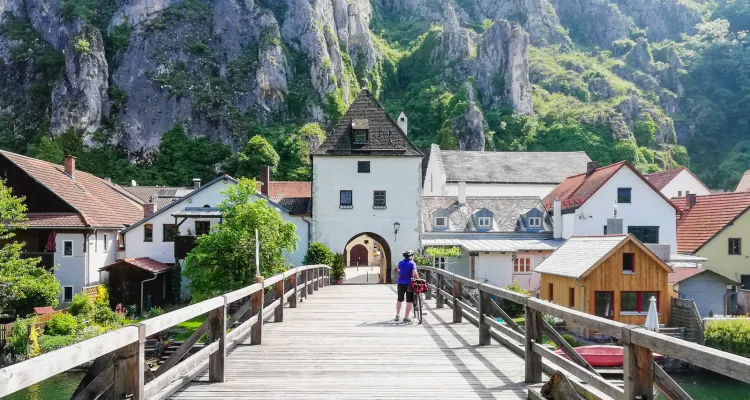
We were looking forward to the routes along the Main-Danube Canal, Altmühl, Naab, Vils and Pegnitz and the beautiful towns of Neumarkt, Berching, Riedenburg, Kelheim, Regensburg, Amberg, Hersbruck and Lauf. What we noticed along the way are, of course, snapshots that we don't want to generalize, because "all generalizations are wrong, including this one" (Alexander Chase, *1926, American journalist).
Show more Show lessDay 1: Arrival in Nuremberg
The beautiful private hotel "Prinzregent" in a prime location directly on the Pegnitz River did not have a manned reception desk, but the door opened when we entered a code. Our travel documents were available. Unfortunately, we couldn't leave the car in the hotel parking lot for a week and had to park it about a kilometer away in a parking lot on the Wöhrder Wiese on the banks of the Pegnitz. We weren't entirely comfortable with this, as our car might have been the only one there at night. For six whole nights.
There was still time for a tour of the city. The entrance from the Pegnitz parks through a gate in the city wall offered an unusually beautiful view of the old town, which we were of course only able to admire in fragments. The Germanic National Museum is closed on Mondays. So there was no opportunity to visit it today or in a week's time. We walked back to the hotel along the Pegnitz to the Wöhrder Wiese subway station. We'd better have made a note of this, as we were due to start from there the next morning.
In the hotel, we looked at the very good map material, a foldable waterproof map, the ring binder with the hotel directions and a Leporello (a foldable booklet in the form of a long strip folded up like an accordion) with particularly detailed maps. Opera connoisseurs may be reminded of the register of sins in Don Giovanni, performed by servant Leporello in the so-called Leporello aria.
Show more Show lessDay 2: Nuremberg - Neumarkt, 50 km
The reception was now manned and there was a good breakfast if you approached the buffet wearing a mask and foil gloves (like the ones at petrol stations). The reception wished us a safe journey and showed us the way to the Wöhrder Wiesen, which we already knew and where we saw our car again undamaged.
We drove for a long time along the Pegnitz and Wöhrder See through a beautiful park and water landscape. One of the first sights was the historic Hammer factory. Brass products were manufactured in the hammer mill from 1492 until it was destroyed in the Second World War. Towards the end of the 18th century, there was a hammer with a forge, rolling mill, grinding mill and several houses. The "Nuremberg lords of the manor" von Volckamer and von Forster ruled the land. In 1814, the small village passed to the von Forster family, who moved the obelisk here from the Volckamer garden. An occasional glance at the leporello and the blue signs for the Five Rivers Cycle Route confirmed that we were on the right track.
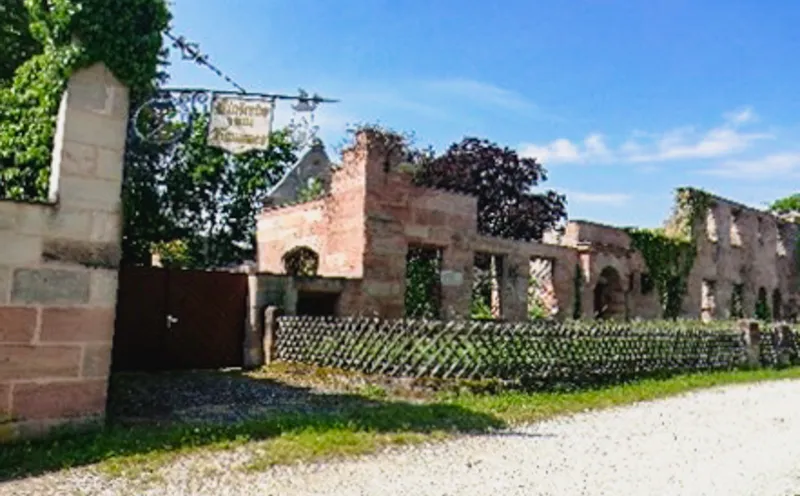
We soon reached the pretty little town of Lauf. During a short break, the ever-vigilant and clever Angi found out that we weren't supposed to be in Lauf, but in Feucht. So we had gone in the wrong direction. The Leporello showed the tour in the opposite direction and disappeared into the pannier so as not to confuse us again. Fortunately, the disaster alarm could be switched off. The problem was solved.
In the village of Henfenfeld, we switched to the Pegnitz-Laaber path, which leads almost directly to Neumarkt without significantly extending the daily mileage and gave us a 6th river, the Laaber. As an aside, we also saw Altdorf. And just as we were beginning to feel tired after a steep climb, we came across the Five Rivers Cycle Route near Gnadenberg, as if nothing had happened. On the way, we saw very well-kept houses and gardens even in the small villages. Obviously, there is work around Nuremberg and people enjoy their own homes. The whole of Franconia seemed well maintained to us, by no means poor, but not ostentatiously rich either.
The Hotel Lehmeier on the market square in Neumarkt was good and should also have good food, but it is closed on Tuesdays. Along the deserted market street, we only saw two open restaurants with chairs and tables on the street, of which we liked the Greek one a little better. First of all, we were in desperate need of a drink and were very happy about the beer. On the menu, we spotted the note: starter plate for one person, also for 2 people. We asked if this would double the price, which was somewhat grumpily denied, and bravely ordered the double plate. While we waited, we continued to quench our thirst and had the opportunity to observe the crowd, no doubt regulars. The bearded and tattooed gentlemen seemed to be practiced in fighting thirst on a daily basis. Perhaps they drank as a preventative measure to avoid thirst in the first place. One of them passed his young dog around, who was delighted with them all and wanted to lick them. After a while, the dog owner folded up his dog's drinking bowl, hung it (the bowl) on his belt and said a friendly goodbye with his dog. A few walkers passed by. As we were still hesitating to order a third half liter, the starter plate finally arrived, a surprise, a huge tray with the most delicious things. We ordered the recommended Greek red wine, which was indeed excellent, dark, full-bodied, velvety, dry. No Domestos, as the host assured us.
Show more Show less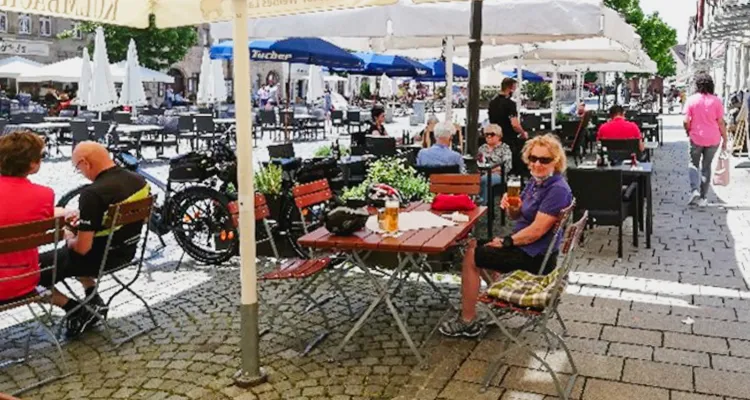
Day 3: Neumarkt - Riedenburg, approx. 60 km
On the Ludwig-Danube-Main Canal, which is no longer used for shipping, we cycled a long, beautiful stretch as if in a green tunnel to Berching, the historic town with the preserved town wall, 4 gates and 13 towers. The opera composer Christoph Willibald Gluck was born here. For once, we associated the name with a beer garden, but we still had water in our panniers. On the way, we passed the important factories of the Max Bögl company.
In Plankstetten, however, we couldn't get past the Benedictine abbey. We descended and admired the huge complex, which is being extensively restored with a lot of funding. Max Bögl was also present here with large machines and vehicles. The seemingly self-sufficient abbey has a beautiful church, meeting places, its own farm, workshops, a restaurant and a large organic farm store. As it was already after 12.00 noon, we decided to stop here for lunch.
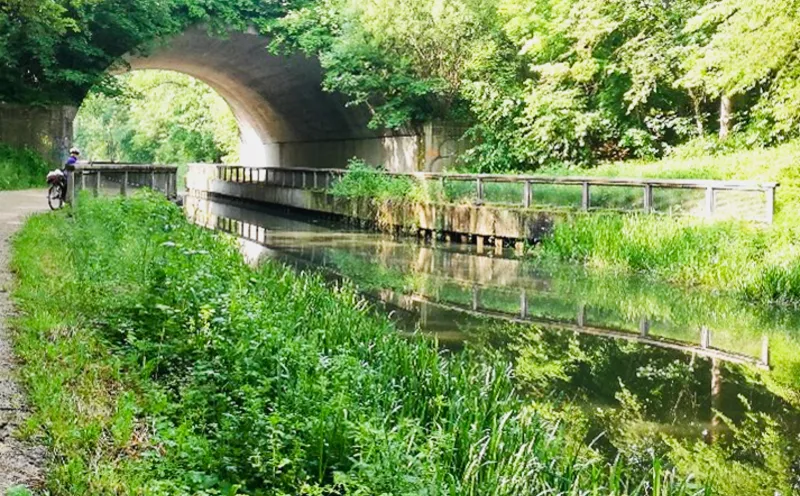
In the organic food store, we had a giant fresh bread roll with a huge slice of the best Leberkäs for just €2. We drank Bioradler from the bottle with a view of the large abbey courtyard and were well satisfied with a feast for the eyes and stomach. All seemed right with the world here, not only because of the large portions but especially because of the informative, good-humored Franconians around us and the well-kept nature and villages. After the monastery, it took us a while to cycle back and forth because we hadn't immediately spotted the cycle path sign hidden behind a corner of the monastery wall.
At Beilgries, we now followed the Altmühl, which we had been looking forward to. Unfortunately, the cycle path was closed and we had to take country roads and detours. Only from Mühlbach were we able to follow the banks of the Altmühl again. But then heavy rain set in, accompanied by thunder and lightning. Our rain gear only protected us at the beginning. Because we were riding on a freshly graveled path, the bikes and we showed a kind of guinea fowl effect. The Gasthof zur Post was by far the most modest accommodation on the trip. The extensive core renovation, as stated in the description, might have been noticed by a building expert. We couldn't notice it. As if the travel planners had wanted it that way, this third inn was also closed, but that didn't bother us here. Of the two open restaurants, the "Schwan" proved to be excellent. We were curious about the pizza with figs and Greek cheese, which turned out to be a good choice.
Show more Show lessDay 4: Riedenburg - Regensburg, approx. 60 km
Our clothes were dry again and the sun was shining. We continued along the Altmühl to Kelheim. We had already visited the Befreiungshalle years ago and enjoyed the view. Now we left it at the top because such victory monuments always signify the senseless death of many soldiers. Unfortunately, this kind of theoretical silent pacifism doesn't help anyone. In picturesque Essing with its castle, we also saw the Schneider beer hotel with a terrace directly on the Altmühl again. A 190-metre-long wooden bridge over the Altmühl and Main-Danube Canal was the longest bridge of its kind when it opened in 1986. At Essing, the Altmühl flows into the Danube, which we now follow. Unfortunately, initially along a busy road again as far as Bad Abbach.
We soon reached Regensburg via Sinzig. According to the map, the hotel behind the third bridge in the old town should be easy to find. We wandered back and forth for a while until we finally found the entrance to Tändlergasse at Krauterermarkt. A large sign above a drugstore pointed the way with an arrow into the narrow alleyway, which we could fit into with our bikes. The listed Hotel Münchner Hof with its centuries-old tradition was the best hotel for us on this trip.

After showering and changing, we immediately set off to explore the city. It was raining a little, but with the hotel's green umbrellas it hardly bothered us. The medieval skyscrapers and modern stores on the first floor offered plenty of interesting and historical sights. Regensburg must have once been very rich and important and it still is, rich at least in historical buildings, many of which are being restored. We were of course impressed by St. Peter's Cathedral.
We were struck by the punning business names and slogans:
"Have a N Ice day" outside an ice cream parlor, "Ace & tate" as in ace head or aesthete outside a cosmetics chain, "Noveltea" as in novelty or new tea for a drink made from 70% oolong tea and 30% whisky, or "Enchan Tee" as in enchanté (French for "to know you").) "Pleased to meet you" for a tea bar.
For dinner, the Spaghetteria AQVINO in sacred rooms with pointed arches seemed suitable. We ordered the starter plate for two and a pasta dish for the main course, but were warned by the friendly waitress that the portions were not small. As we had already learned that only large plates and glasses are known in Franconia, we made do with a portion of tagliatelle with frutti di mare, which was still too much, albeit very good.
Show more Show lessDay 5: Regensburg - Amberg, approx. 70 km
The route from the city center and the Danube to Mariaort an der Naab seemed quite easy afterwards. However, we were so confused by the signposting that we initially cycled in the wrong direction from Mariaort. That was annoying, of course, because the intended route was already long enough. But then it went well on very nice quiet paths.
At Duggendorf, the "Schlosswirtschaft" with its shady beer garden was right on the cycle path. Just right for a lunch break. On the menu was "Homemade Bratensulz" for €8.50, which we were keen to try. Pleasant surprise: the Sulz was the best we had ever eaten. The portion was of course huge again. Because of the midday heat, we drank a shandy with it, which may not have been hearty, but it was reasonable. We promised the landlady we'd come back if the opportunity arose.

We were already familiar with Kallmünz from a previous visit. Back then, we had climbed the hill with the castle ruins and enjoyed the sweeping views. On the way down, we saw the residents grilling eel in front of a house. We were kindly invited to taste it. We also had fond memories of the tiny inn "Zum Bürstenbinder" on the meadow. Now we were glad that our route crossed the entire old town again, including the wood artist's studio and the café with its garden right next to the cliff.
Amberg greeted us with a wide green belt where thousands of young people played all kinds of sports. Amberg seemed like a youth town to us, which could be explained by the location of the university. The exact name of the university is Ostbayrische Technische Hochschule Amberg-Weiden (OTH). Years ago, I had given a lecture there at the invitation of Prof. Versch, a pioneer of Internet research. Our current hotel, the Vienna House Easy Amberg, didn't exist back then. It is modern and open, has nice large rooms and is located in the middle of a park next to the Kurfürstenbad and yet close to the old town on the Vils. We took a long walk through the interesting and cozy old town. The numerous places were seated and occupied like beer gardens. The whole of Amberg was one big beer garden in the evening.
Show more Show lessDay 6: Amberg - Reichenschwand, approx. 50 km
We cycled along a railroad line to Poppenricht and, after crossing the town, returned to the railroad line to Sulzbach-Rosenberg, which was reached after overcoming quite a climb. In this town, we had to follow the main road. We lost our bearings and therefore followed the main road to Nuremberg because we saw on the map that we should rejoin the Five Rivers Cycle Route at the village of Kauerhof. Like us, other cyclists were also looking for the right way in Kauerhof. We did find the place where we should have come here, but the rest of the route seemed to lead us back to the main road. Fortunately, we were joined by a group of cyclists who showed us that we had to go back a few meters on the main road to suddenly reach a good cycle path at a construction site next to the inn behind the farm.
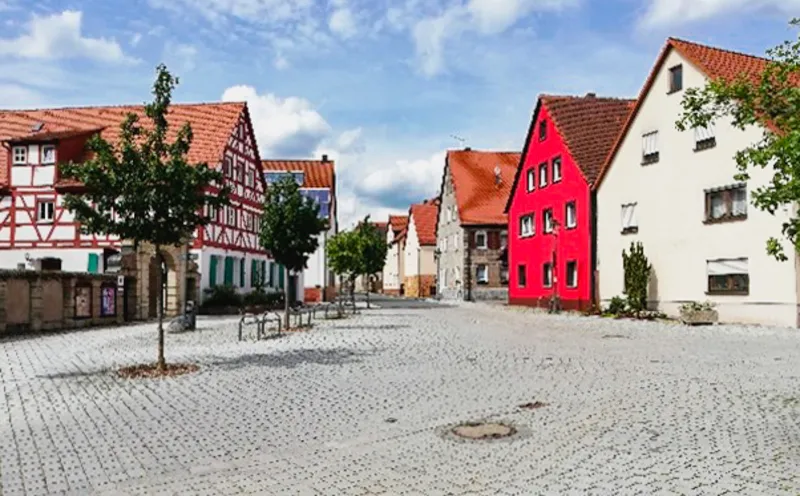
From here, everything went well as far as the route was concerned. However, there were many climbs and descents and a strong headwind. At lunchtime in Etzelwang, the Landgasthof Peterhof was temptingly situated on the cycle path. The menu didn't reveal any culinary surprises, so we ordered sauerbraten and Berlin-style liver with onion rösti, which we hadn't eaten for a long time but didn't seem particularly Franconian. But it was, as far as the size of the portions was concerned, which would have fed two "Saxon-Prussian" families.
Well fortified, we cycled on to Henfenfeld, where our journey came full circle. From here we had cycled to Neumarkt. Now all we had to do was find our hotel in Reichenschwand. This should have been easy, but it wasn't for us because we had overlooked cycle route signs or there were none. The whole tour showed that it is better to cycle at least in pairs so that no signposts are overlooked. Incidentally, this stage of the day was the least enjoyable of the whole tour.
The Dormero Schloßhotel is an impressive castle with a large park, perfectly, stylishly modernized with the latest design, with large rooms, spacious bathrooms and a huge TV. The restaurant was closed. There was a note in the room saying that the bar was open when reception was occupied. However, the receptionist didn't want to serve drinks, even though she was serving food and drink to the participants of a seminar in front of us. So we went into the deserted town but couldn't find a restaurant. Now it turned out to be an advantage that we had eaten such a sumptuous lunch. We watched a Donna Leon movie on the TV and wanted to turn it off, but we couldn't do it. We called reception, who sent a technician who didn't know what to do either. Then the receptionist came, reached behind the big screen and pulled out a cable.
Show more Show lessDay 7: Reichenschwand - Nuremberg, approx. 40 km
The last short stage took us back to the way we had mistakenly cycled on the first day. One of the most beautiful routes, we thought. We passed Lauf and Hammer again. The traffic on the cycle path became heavier and heavier the closer we got to Nuremberg. Explainable, because it was a warm Sunday.
The meadows by the Pegnitz and Wöhrder See were full of mostly young people sunbathing, swimming or playing ball. Among the cyclists, we could distinguish between several groups: unpretentious people in everyday clothes on sometimes very old bicycles, sporty youth on racing bikes in perfect sportswear, fashion-conscious youth on city bikes without gears, mudguards, luggage racks, lights and bells, older couples in sportswear on pedelecs, combat cyclists, i.e. totally black-clad, stocky men on mountain bikes with wide off-road tires. Almost all of them were riding at high speed, and the latter group was quite reckless. Because of the noiselessness of the cyclists, it was sometimes dangerous, even for the many pedestrians. We passed the parking lot of our car and were relieved to see it undamaged. Good Nurembergers!
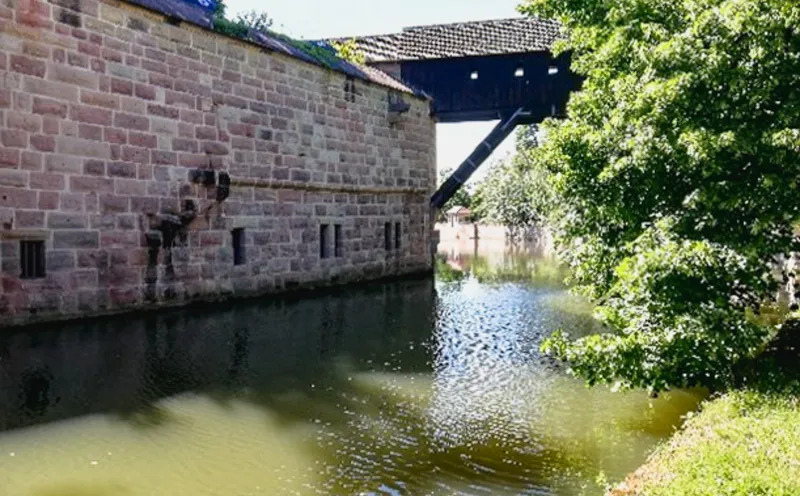
First of all, however, we drove on to our hotel, where the luggage transport had already dropped off our suitcase. We showered and made our way into Nuremberg city center. It wasn't too late for lunch, which we found at Haus Krakau, a former watchtower of the city wall. This restaurant with beer garden consists of the guest rooms on the second floor of the tower, a wooden bridge with further guest rooms and a beer garden on the level of the upper street. To our surprise, the restaurant was under Polish management and offered Polish dishes and Polish beer as well as Franconian food. We opted for two types of pierogi, which were very good. As the beer garden was not suitable for a midday nap, we immediately moved on to sightseeing. There is not enough space here to describe how many interesting and beautiful things we saw. We ended the evening in the courtyard of the Julius-Spital, where we also had a glass of wine.
The next morning, we loaded up our car and drove home, very satisfied with what we had experienced and with our driving performance.
Show more Show less

